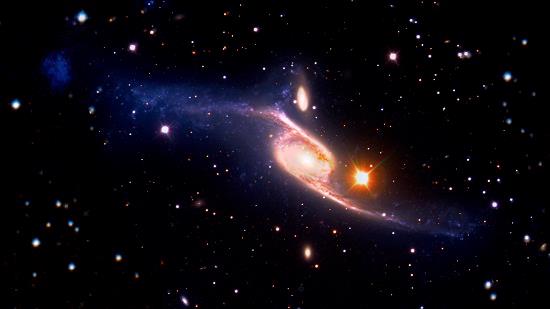
212 million light-years from Earth, NGC 6872 drifts silently through the cosmos. At first glance, NGC 6872 seems like any other spiral galaxy. And in truth, it is like any other spiral galaxy, except that NGC 6872 is amazingly huge. In fact, NGC 6872 is one of the largest known spiral galaxies.

This cosmic beast spans over 522,000 light-years. For comparison, the Milky Way is some 100,000 light-years across, while our closest galactic neighbor (Andromeda) is roughly 260,000 light-years across. Which means that NGC 6872 could swallow both and still have room to spare.
What made NGC 6872 so large? According to calculations, hundreds of millions of years ago, a nearby galaxy (IC 4970) passed by NGC 6872. The two bodies were close enough that NGC 6872 was stretched and pulled into the behemoth that it is today. The gravitational interactions between these galaxies further expanded NGC 6872 by producing new star-forming regions, where stellar objects much younger than the other stars are now being born. In fact, without these regions of infant stars, NGC 6872 would not have its current number-one ranking.
Oddly enough, the same gravitational interactions that made NGC 6872 so enormous will also bring about the galaxy’s death. Of course, galaxies can’t actually die… but they can be ripped apart.
And that’s exactly what’s happening to NGC 6872. Due to the gravitational pull of IC 4970, one of NGC 6872’s massive arms seems to be spinning off to form its own dwarf galaxy. And in about four billion years, something similar will happen to our own galaxy. Recently, an analysis of Hubble measurements has revealed that the Milky Way is on a collision course with the Andromeda Galaxy. So, if NGC 6872 is a comparable example, some time in the future, it is plausible that we might be a part of the largest spiral galaxy.
Of course, given the 4 billion year time-frame, it’s highly unlikely that we will be around to celebrate this achievement.